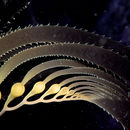en
names in breadcrumbs


Numerous species of small invertebrates and even fish can be found living in the holdfasts of Macrocystis pyrifera. In a study in M. pyrifera forests around Navarino Island, Chile, Ojeda and Santelices (1984) found 42 species of invertebrates and 1 fish living in kelp holdfasts. Five invertebrate phyla were represented, but especially prominent were crustaceans (especially decapods), echinoderms, and molluscs. The authors note that in a similar study in California, over 100 invertebrate taxa, mostly amphipods, polychaetes, and isopods, were found dwelling in M. pyrifera holdfasts (Ghelardi 1971, cited in Ojeda and Santelices 1984).
In giant kelp forests, shade from the canopy of M. pyrifera negatively affects understory algae. Because these algae compete for space with sessile (i.e., stationary) invertebrates, the shade from the giant kelp indirectly benefits the sessile invertebrates. In a study off San Clemente, California (USA), this indirect positive effect turned out to be quite substantial (Arkema et al. 2009).
Hernandez-Carmona et al. (2006) reviewed the literature on long-distance dispersal of giant kelp (Macrocystis pyrifera). Long-distance dispersal is believed to occur via drifting sporophytes. Drifting M. pyrifera sporophytes (kelp rafts) are created following sporophyte detachment from benthic substrates; in California, this occurs primarily during the winter months (November–February). Kept afloat by numerous pneumatocysts (gas-filled bladders), M. pyrifera sporophytes may remain alive and adrift for more than 100 days. Zoospore germination rates remain fairly high even after several months of floating. Based on their investigation of the rate of fertility decline while afloat, Hernandez-Carmona et al. (2006) conclude that the reproductive longevity of drifting M. pyrifera sporophytes is long enough to support effective long-distance dispersal of over 1000 km. Drifter reproductive viability is maintained at relatively high levels so long as enough biomass is present to promote the production of spore-bearing sori.
Kelp rafts disperse kelp, but they may also disperse an enormous diversity of kelp forest fauna among isolated kelp forests. Some pelagic species with larval dispersal may even complete a cycle of larval settlement, growth, and reproduction before kelp rafts sink or wash ashore (Hobday 2000).
Macrocystis is the most widely distributed kelp genus in the world, with an amphitropical distribution that spans the west coasts of North and South America and also includes Argentina, South Africa, Australia, New Zealand, and most of the sub-Antarctic islands (Neushul 1971, cited in Hernandez-Carmona et al. 2006). Macrocystis pyrifera forms dense forests in many parts of the world, including parts of the northeast Pacific (but not north of San Francisco, California), the southern shores of South America, many Southern Ocean islands, and isolated areas of South Africa, Australia, and New Zealand (Dayton 1985).
According to Abbot and Hollenberg (1976), M. pyrifera occurs on the west coast of North America from Alaska to Baja California.
Kelp forests experience irregular cycles of growth and deforestation. The biotic (biological) and abiotic (physical) factors driving these changes, both "natural" and anthropogenic, have been the subject of much study by ecologists over many decades and in several parts of the world (see, e.g., Dayton et al. 1998). Steneck et al. (2002) review the major factors controlling the development and disappearance of kelp forests, including M. pyrifera forests. They find that between about 40 and 60 degrees north in both hemispheres, well developed kelp forests are most threatened by herbivory, usually by sea urchins. Overfishing and loss of apex vertebrate predators such as sea otters have repeatedly led to increased herbivore (e.g., urchin) populations and consequently deforestation of kelp forests. In southern California, however, home to extensive forests of M. pyrifera, widespread deforestation is rare. Steneck et al. suggest that this relative stability may result from functional redundancies among both predators and herbivores (in contrast to less species-rich regions to the north).
Nearly all kelp forests occur on hard substrata, an exception being Macrocystis pyrifera in some protected fjords in Chile and New Zealand (Dayton 1985). Abbot and Hollenberg (1976) describe the habitat of this species as "on rocky substrata or occasionally anchoring in coarse sand, subtidal (6-20 (80) m)"
The life history of Macrocystis pyrifera involves a complex alternation of generations between large diploid (spore-producing) sporophytes and microscopic haploid (gamete-producing) gametophytes. Meiosis within the sporangium of the diploid sporophyte produces haploid microscopic flagellated zoospores, which settle and germinate into male or female haploid gametophytes. These gameteophytes produce male and female gametes, which combine via fertilization to form diploid sporophytes which then grow from microscopic to macroscopic size (Dayton 1985; Ladah and Zertuche-Gonzalez 2007). Based on studies of M. pyrifera in La Jolla, California (USA), Neushul (1963) estimated the minimum time required to complete the sexual cycle to be 12 to 14 months.
Macrocystis pyrifera produces spores year round, but with seasonal peaks (Reed et al. 1997).
In a study near San Diego, California (USA), maximum lifespan recorded for a Macrocystis pyrifera plant was about five years (Dayton et al. 1992).
Dayton et al. (1998) and Steneck et al. (2002) review (and speculate about) how human activities (hunting marine mammals, harvesting urchins, polluting the seas, etc.) from prehistoric times to the present have likely impacted the dynamics of kelp forests, including M. pyrifera forests, in several geographic regions.
Macrocystis pyrifera plants consist of a holdfast, which anchors the plant to the substrate, bundles of fronds analogous to the branches and leaves of a land plant, and reproductive structures called sporophylls located just above the holdfast (Tegner et al. 1996). Like most kelp species, M, pyrifera is perennial. It may exceed 45 m in length and the holdfasts of old plants are conical and may reach a meter in height (Abbot and Hollenberg 1976). Macrocystis pyrifera occurs in extensive stands (kelp forests) throughout its range, providing the basis for biologically diverse ecological communities.